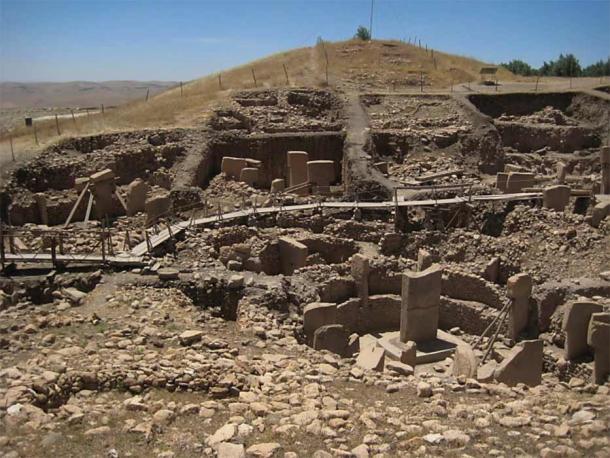Situated in southern Turkey near the upper Euphrates, Gōbekli Tepe has become famous for its surprisingly advanced megalithic architecture and symbolism, seemingly too early for the hunter-gather culture that built it. Enclosure D at Gōbekli Tepe is dated to around 9500 BC, although it is obvious that Gōbekli Tepe’s origin must significantly predate this. How, and more interestingly why, did its builders make such a magnificent structure at such an early time? Something utterly dramatic must have happened to motivate them. This mystery has attracted many to try and interpret the symbols that cover its megalithic pillars. Archaeoastronomy likely holds the key. Considering that Gōbekli Tepe sits at the threshold of the origin of civilization in the region, anything one can learn about this issue is profoundly important.

Left: G ōbekli Tepe, southern Turkey, with its round temple-like enclosures of megalithic pillars. Right: plan view of enclosures A to D, with T-shaped pillars represented by filled rectangles.
In 2017 Sweatman and Tsikritsis proposed that Pillar 43 from enclosure D at Gōbekli Tepe was thought to encode a date using precession of the equinoxes, where the animal symbols represent familiar constellations and the circular disk symbol represents the position of the sun on the summer solstice. The date apparently ‘written’ on the pillar, taking the head and wings of the vulture/eagle symbol to represent the teapot asterism of Sagittarius, is consistent with the Younger Dryas impact to within a hundred years or so.
Other pillars at Gōbekli Tepe appear to support this interpretation. For example, the fox and tall birds on Pillar 33, from which a tangle of snakes leap out, can be interpreted as a very nice picture of the Taurid meteor stream. This is because when Gōbekli Tepe was occupied, roughly 10,000 BC, the Taurid meteor stream would have emanated from Aquarius (the fox) and then Pisces (the tall birds) over the course of a few weeks. And it is this meteor stream that is credited with providing the cometary debris for the Younger Dryas impact, circa 10,800 BC. It is possible, then, that this mighty extinction-level event, which is now essentially confirmed and is thought to have triggered a mini Ice-Age lasting over 1,000 years, also sparked the development of civilization in the Fertile Crescent of south-west Asia.
Please read more at: Possible lunisolar calendar systems at Gobekli Tepe and Karahan Tepe (martinsweatman.blogspot.com)
Like this Preview and want to read on? You can! JOIN US THERE ( with easy, instant access ) and see what you’re missing!! All Premium articles are available in full, with immediate access.
For the price of a cup of coffee, you get this and all the other great benefits at Ancient Origins Premium. And – each time you support AO Premium, you support independent thought and writing.
Dr Martin Sweatman is a scientist at the University of Edinburgh and a Fellow of the Royal Society of Chemistry. He is the author of the book Prehistory Decoded .
Top Image : Pilar 43 in the night sky and time controlling deity, Urfa Man. Deriv (Image: Cobija / CC BY-SA 4.0 )
 RSS Feed
RSS Feed















 March 10th, 2022
March 10th, 2022  Awake Goy
Awake Goy  Posted in
Posted in  Tags:
Tags: 













